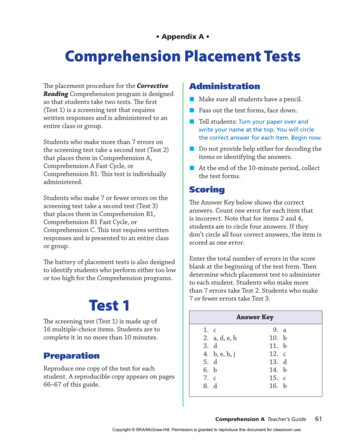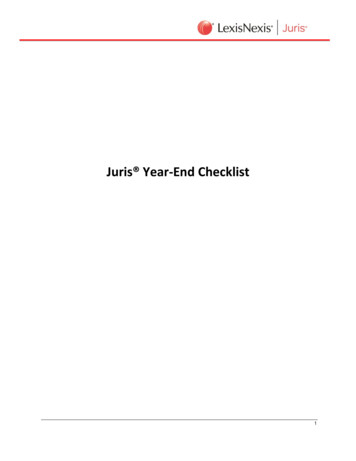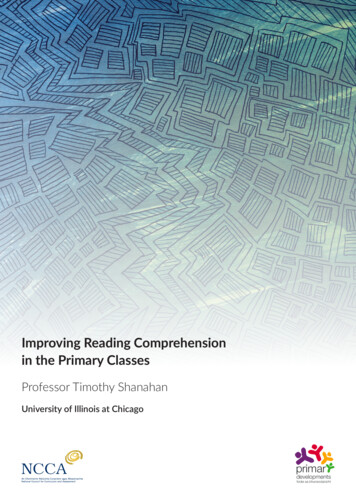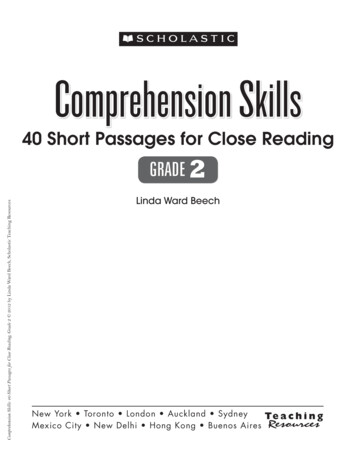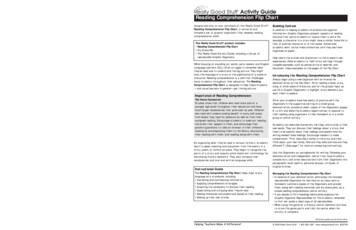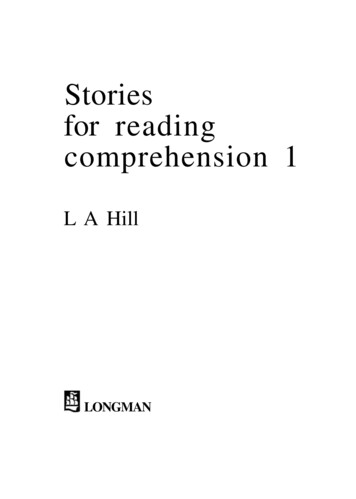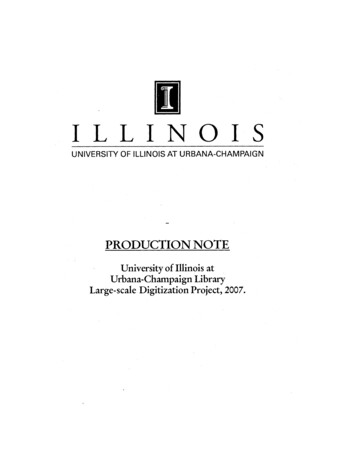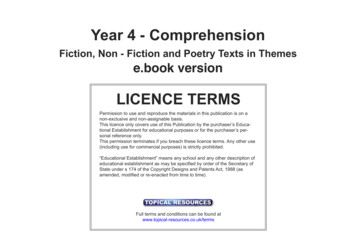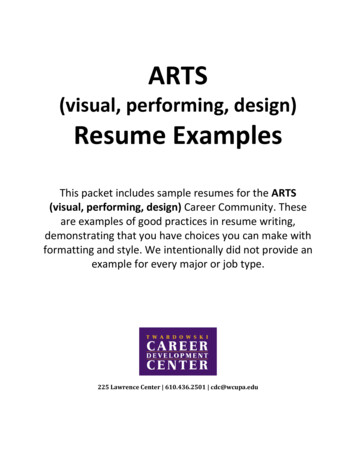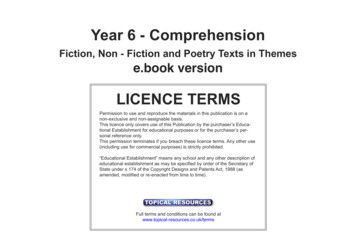
Transcription
To ContentsYear 6 - ComprehensionFiction, Non - Fiction and Poetry Texts in Themese.book versionLICENCE TERMSPermission to use and reproduce the materials in this publication is on anon-exclusive and non-assignable basis.This licence only covers use of this Publication by the purchaser’s Educational Establishment for educational purposes or for the purchaser’s personal reference only.This permission terminates if you breach these licence terms. Any other use(including use for commercial purposes) is strictly prohibited.“Educational Establishment” means any school and any other description ofeducational establishment as may be specified by order of the Secretary ofState under s 174 of the Copyright Designs and Patents Act, 1988 (asamended, modified or re-enacted from time to time).Full terms and conditions can be found atwww.topical-resources.co.uk/terms
ContentsYEAR 6 - ComprehensionFiction, Non-Fiction and Poetry Texts in ThemesIntroductionYear 6 Comprehension is a collection of fiction, non-fiction and poetry texts grouped inthemes suitable for the age group. These exercises can be used to prepare children for SATstyle tests or matched to themes the class may be studying at the time. The question pagesare split into three sections. Section A gives an overview of the text with missing words orphrases to find, Section B contains open-ended questions and Section C is a relevant writtenchallenge for more able pupils or those who work quickly. All the pages have been printed‘Landscape’ to make maximum use of the space on Interactive Whiteboards. Black and whiteimages are used in the paper book; full colour images have been used in the e.book anddownload.Texts written by:Peter Bell, Heather Bell, Kath Cope, Sue Garnett, George Stewart and Charles DickensTopical Resources publishes a range of Educational Materials for use in Primary Schools andPre-School Nurseries and Playgroups.For the latest catalogueTel 01772 863158Fax 01772 866153Email: sales@topical-resources.co.ukVisit our Website at:www.topical-resources.co.ukCopyright Peter BellFirst Published April 2011ISBN 978-1-907269-51-6Illustrated by John Hutchinson, Art Works, Fairhaven,69 Worden Lane, Leyland, PrestonDesigned by Paul Sealey, PS3 Creative, 3 WentworthDrive, Thornton, LancashirePrinted in the UK for ‘Topical Resources Ltd’ byT. Snape and Co Ltd., Boltons Court, Preston,Lancashire1Permission to use and reproduce the materials in thispublication is on a non-exclusive and non-assignablebasis. This licence only covers use of this Publicationby the purchaser’s Educational Establishment foreducational purposes or for the purchaser’s personalreference only. This permission terminates if youbreach these licence terms. Any other use (includinguse for commercial purposes) is strictly prohibited.“Educational Establishment” means any school andany other description of educational establishment asmay be specified by order of the Secretary of Stateunder s 174 of the Copyright Designs and Patents Act,1988 (as amended, modified or re-enacted from time totime).Terms and conditions can be found atwww.topical-resources.co.uk/termsTopical Resources is the trading name of Topical Resources Ltd,registered in England number 8072582.Registered office: Jumps Farm, Durton Lane, Broughton, Preston, Lancashire. PR3 5LE Topical Resources Ltd.Theme: VictoriansThe CircusHarriet Lister – HousemaidThe History Of The CircusTheme: Mountain EnvironmentThe Final PushThe Conquest Of EverestThe ClimbTheme: SightBeauty The Guide DogHow The Eye WorksLouis BrailleTheme: RiversRiver RescueThe River AmazonFury Over Thames Toll ChargesTheme: CastlesCome To Willaby CastleThe History Of CastlesThe Family OutingTheme: FoodSlaving Over A Hot StoveSchool Dinners Or Sandwiches?A Balanced DietTheme: TalentOur School’s Got TalentLetter Of ComplaintThe Talent ShowTheme: CavesStranded In A CaveSchool Visits – Are They Worth Doing?The 4464850Subject to Topical Resources LICENCE TERMS available at: www.topical-resources.co.uk/terms
Theme 1 VictoriansFictionBack to ContentsCIRCUSTHEThe story is set in Victorian Times. TheGradgrind children have been brought upvery strictly. Their father believes theyshould spend their time learning facts.He believes there is no time to wasteenjoying life or having fun. One day thechildren decide to make a secret visit tothe circus. Unfortunately, their fathercatches them watching the circus acts.This is how the story continues.2Dumb with amazement, Mr Gradgrind crossed tothe spot where his family was thus disgraced, laidhis hand upon each erring child, and said:“Louisa! Thomas!”Both rose, red and disconcerted. But, Louisalooked at her father with more boldness thanThomas did. Indeed, Thomas did not look at him,but gave himself up to be taken home like amachine.“In the name of wonder, idleness and folly!” said MrGradgrind, leading each away by a hand; “what doyou do here?”“Wanted to see what it was like,” returned Louisashortly.“What it was like?”“Yes father.”.“Thomas, though I have the fact before me, I find itdifficult to believe that you, with your education andresources, should have brought your sister to ascene like this.”“I brought him, father,” said Louisa, quickly. “Iasked him to come.”“I am sorry to hear it. I am very sorry indeed tohear it. It makes Thomas no better, and it makesyou worse, Louisa.”She looked at her father again, but no tear felldown her cheek.“You Thomas and you, to whom the circle of thesciences is open, Thomas and you, who may besaid to be replete with facts; Thomas and you, whohave been trained to mathematical exactness; Topical Resources Ltd.Thomas and you here!” cried Mr. Gradgrind. “Inthis degraded position! I am amazed.”The children return home in disgrace, and are metby their father’s friend Mr. Bounderby, an equallystrict Victorian gentleman.“Well!” blustered Mr Bounderby, “what’s thematter? What is young Thomas in the dumpsabout?”He spoke of young Thomas, but he looked atLouisa.“We were peeping at the circus,” muttered Louisahaughtily, without lifting up her eyes, “and fathercaught us.”“And Mrs Gradgrind,” said her husband in a loftymanner, “I should as soon have expected to findmy children reading poetry.”“Dear me,” whimpered Mrs Gradgrind. “How canyou, Louisa and Thomas! I wonder at you. Ideclare you’re enough to make one regret everhaving had a family at all. I have a great mind tosay I wish I hadn’t. Then what would you havedone, I should like to know.”Mr Gradgrind did not seem favourably impressedby these cogent remarks. He frowned impatiently.“As if, with my head in its present throbbing state,you couldn’t go and look at the shells and mineralsand things provided for you, instead of circuses!”said Mrs Gradgrind.Subject to Topical Resources LICENCE TERMS available at: www.topical-resources.co.uk/terms
Theme 1 VictoriansFictionCIRCUSTHESection AChoose the best word or group of words to fit the passage and put a ringaround your choice.The Gradgrind children, Louisa and Thomas, are caught watching the circuswithout permission. Father asked, “What do you rs Gradgrind.Mr Bounderby.3ThomasLouisaMrs GradgrindMr Bounderby4ThomasLouisaMrs GradgrindMr Bounderby5difficult“Wanted to see what it was like,” returnedFather said he found it difficult to believe thathad broughtto a scene like this . “Thomas and you here!” cried Mr Gradgrind. “In thisuncomfortableposition! I am amazed.”On their way home they met6a clownMr Gradgrindunnecessarya policemandegradedMr Bounderbyan equally strict Victorian gentleman. “What’s the matter?” he said.3 Topical Resources Ltd.1Section BBack to ContentsWhat does Mr Gradgrind believe his children should be doing?2Why do you think the children decided to make a secret visit to the circus?3What does the phrase ‘red and disconcerted’ imply?4What did Mr Gradgrind think that Thomas had done?5What reasons did Mr Gradgrind give for being ‘amazed’ at finding Thomasat the circus?6How did the children know Mr Bounderby?7“We were peeping at the circus,” muttered Louisa haughtily, without liftingher eyes, “and father caught us.” What does this sentence suggest abouthow Louisa was feeling?8Who regretted ‘ever having a family at all’?9What did Mrs Gradgrind think the children should have been doing insteadof looking at circuses?Section CImagine a circus has come to your town. Write a short story in which you arecaught making a secret visit to the show.Subject to Topical Resources LICENCE TERMS available at: www.topical-resources.co.uk/terms
Theme 1 VictoriansBack to ContentsNon-Fiction (Autobiography)Harriet Lister – HousemaidMy name is Harriet Lister and I am 19 years old, I work as a housemaid in a largehouse in London. My day begins at 6am when I make a cup of tea for Mrs Sawyerwho is the Housekeeper. After the mistress, Mrs Sawyer is the most importantperson in the house so it’s very important to keep on the right side of her unless youlike being in trouble!My first job of the day is to light the fires in the downstairs rooms, it’s a dirty joband I’m always glad to wash my hands before taking hot water up to the familybedrooms for them to start getting ready for their day.While they are busy we make a start on the laundry by putting the clothes to soak.There are six people in the family here and it’s amazing how many outfits they weareach day.While the family are at breakfast, I make the beds and clean the bedrooms beforemoving downstairs to dust, polish the brasses and sweep the floors. This has to bedone before visitors start arriving.Once the house is clean, it is then time to go and continue with the laundry. We areup to our elbows in soap suds as we scrub the clothes until they are clean and thenwe rinse and rinse and rinse again before wringing the water out of them and hangingthem out to dry. My hands are often very sore, especially in winter.4Harriet’s bedroom would be verysimple, containing a wooden bed,straight-back wooden chair, dresserand basic washstand. She couldexpect to be paid ten pounds sevenshillings a year.During the day, I have to carry scuttles full of coal around the house to makesure the fires don’t go out, it’s heavy work. As soon the washing is dry we start onthe ironing.We never stop working from the moment we get up to the moment we drop into bedabout half past ten at night. Still, I am very lucky because once a month I get togo home and see my mother and father for half a day and Mrs Sawyer sometimeslets me take some cakes and biscuits for them. Topical Resources Ltd.List of Rules Given to Harriet onher First Day1.When spoken to, standstraight, keep your hands stilland always look at the personspeaking to you.2. Never let your voice be heardby the ladies and gentlemenof the household unless theyhave spoken to you.3. Never address the ladies andgentlemen unless you aredelivering a message.4. When you receive an order,always use the properaddress, ‘Sir’, ‘Ma’am’ or‘Miss’.5. Never offer your opinion toyour employer.6. Always give room when youencounter your betters in thehouse, that is to say makeyourself as invisible aspossible and avert your eyes.7. If you are required to walkwith a lady or gentleman inorder to carry packages,always walk a few pacesbehind.8. You may not receive anyrelative, visitor or friend intothe house.9. You may not receive anyrelative, visitor or friend intothe Servant’s Hall without theconsent of the Housekeeper.10. Any breakages or damageswill be deducted from yourwages.Subject to Topical Resources LICENCE TERMS available at: www.topical-resources.co.uk/terms
Theme 1 VictoriansFictionNon-Fiction(Autobiography)Section BHarriet Lister – HousemaidSection AChoose the best word or group of words to fit the passage and put a ringaround your choice.My name is Harriet Lister and I work as a housemaid. My day begins at15 am6am7am8am2Harriet.the mistress.Mrs Sawyer.Lister.3put on the light.4breakfast5wet washing6half past ninewhen I make a cup of tea forMy first job of the day is toNext I takemake the tea.hot waterheat the water.clean clotheslight the fires.polished shoesup to the family bedrooms for them to start getting ready. During the dayI have to carryironinga sweeping brushscuttles full of coalaround the house to make sure the fires do not go out. We drop into bedaboutten o’clockhalf past teneleven o’clockat night. I am lucky because once a month I get to go home and see mymother and father for half a day.5 Topical Resources Ltd.Back to Contents1Who is the most important person in the house?2Why is it important to keep on the right side of Mrs Sawyer?3Why do you think the first job of the day is to light the fires?4Why is there so much laundry to do in this house?5‘My hands are often very sore, especially in winter.’ Why do you think thisis the case?6What do you understand by the term ‘scuttle full of coal’?7Give two reasons why Harriet thinks she is very lucky?8What does the rule ‘Never address the ladies and gentlemen unless youare delivering a message,’ mean?9Rule 7 states ‘If you are required to walk with a lady or gentleman in orderto carry packages, always walk a few paces behind.’ Why do you thinkthis rule was written?Section CImagine you are a maid or servant in a large Victorian house. Write atimetable for your long day fitting in as many different jobs as you can.Subject to Topical Resources LICENCE TERMS available at: www.topical-resources.co.uk/terms
The HistoryTheme 1 VictoriansBack to ContentsNon-Fiction (Impersonal Writing)Circusof theThe word ‘circus’ is of Latin origin and means ‘circle’ or ‘ring’. The Romans builtcircular stadiums for their chariot races and these were called ‘circuses’. PhilipAstley founded the first modern circus in London in about 1770. He gave horsedisplays accompanied by acrobats, musicians and a clown.Astley found that his horses performed best in a circular place, so he enclosedhis performance area by a ring. Astley called his show a riding school. A rivalshow set up by Charles Hughes in 1782, called the Royal Circus, was the firstto use the word circus in the title. Following this, the idea of a circus performedin a ring spread to Europe and North America.A Londoner, John Bill Rickets, set up the first circus in America. His circusfollowed the now established pattern of using performing horses and riders,acrobats and a clown but was the first to travel from town to town. Horses werethe mainstay of the early circus performance but gradually other animals wereintroduced. The animal trainer Isaac Van Amburgh was said to be the first manto put his head inside a lion’s mouth. America’s first elephant arrived in 1796.Among the first travelling circuses was that of Aaron Turner. In about 1830 itbegan performing outdoors under what may have been the first circus tent or‘big top’. Turner’s tent was 28 metres across, providing space for a few hundredwooden seats, which could be dismantled and moved in a horse drawn wagon.Travelling menageries (collections of animals) were popular about the sametime. By 1870 the menagerie had become part of every circus. The circus wasoften presented in two tents, one for a variety of circus acts and a secondreserved for the display of animals. Special wagons had to be built. The giraffe,for example, required a tall, padded wagon in order to protect its neck duringtransportation. The hippopotamus had a large tank of water built inside itswagon.In 1871 P. T. Barnum formed a circus that was billed as ‘The Greatest Show onEarth’. He purchased 65 railway carriages and became the first to transport hisequipment, performers and animals in his own railway train. Other Americancircuses soon followed this idea as it was much easier than using horse drawntransport.6 Topical Resources Ltd.ClownstheSince the early days ofaenbevehacircus, clownsrietyvagdinmajor attraction, adhenW.and humour to the show, thecircus tents were smallgingsinasdclowns entertaine1870By.and talking comediansso largecircus tents had grownors couldthat not all the spectats. Sincehear the clowns’ voicehavethat time most clownsmimed.Famous AnimalsJumbo the elephant was amongthe main attractions of theBarnum and London circus from1882 until 1885, when he wasstruck and killed by a railwayengine. His name has now cometo mean anything big such asjumbo jets or jumbo sausages.The Circus RingAlthough circuses havechangedin many ways over theyears thering itself is still the same size inevery land, 13 metresacross.The circus programmehasgenerally remained unchangedalso. A traditional circus usuallyincludes clowns, jugglers, horseacts and acrobats. Wildanimalacts are now less popular thanthey once were.Famous PerformersMany performers becamefamous by the unusual nature oftheir acts. In 1897 Alan ‘TheHuman Arrow’ was the first to beshot through the air from a giantcrossbow. Audiences werestartled by the Zacchini Family’shuman cannonball act in which afamily member was shot from acannon and landed in a net.Subject to Topical Resources LICENCE TERMS available at: www.topical-resources.co.uk/terms
Theme 1 VictoriansSection ANon-Fiction (Impersonal Writing)The HistoryCircusof the1Section BBack to ContentsWhere does the word ‘circus’ come from?2Why did Philip Astley hold his performances in a ring?3Who was the first man to put his head inside a lion’s mouth?4What is a menagerie?He gave horse displays accompanied by acrobats, musicians and a5Why do you think P.T. Barnum called his circus ‘The Greatest Show onEarth’?Charles Hughes first used the word6What does the word ‘mime’ mean? Why did most clowns mime?7What does a traditional circus programme usually include?8Why do you think ‘wild animal acts are less popular than they once were’?9Why do you think ‘audiences were startled by the Zacchini Family’shuman cannonball act’?Choose the best word or group of words to fit the passage and put a ringaround your choice.Philip Astley started the first modern circus in London in about11782.1830.2comedian.3circuscirclecircular4a giraffea liona tiger5marqueelarge tent6lorrycomic.in 1782. The American circus first saw1870.1770.clown.choir.in 1796. Aaron Turner had the first circus tent called asmall bottomconcentrican elephantbig topin 1830. In 1871 Barnum’s ‘Greatest Show on Eath’ was the first circus totravel bybustrainplaneas it was much easier than using horse drawn transport. Other Americancircuses soon followed this idea.7 Topical Resources Ltd.Section CWrite a short newspaper report describing to your readers exactly whathappened to ‘Jumbo the Circus Elephant’.Subject to Topical Resources LICENCE TERMS available at: www.topical-resources.co.uk/terms
TheFinalPushTheme 2 Mountain Environment8Back to ContentsFictionIt had been raining when they set offand the top of the mountain wascovered in cloud but they couldn’t letanything slow them down, not if theywanted to beat the clock and achievetheir goal, climbing three mountainsummits in twenty four hours. It hadbeen Dad’s idea; a unique way tocelebrate his special birthday. Whenhe’d suggested that they could do ittogether, Ben had been really thrilled.They’d been training for months, rightthrough the year, every season and inall weathers and now as they set off onthe final push to the last summit, itlooked as though the wind and rainwere going to be their companionsright to the top.It was a steep climb and the pathwaywas narrow and very rocky. Theovernight rain had made it very slipperyand Ben was glad that his boots werestrong with a good, thick tread. Heglanced ahead to Devil’s Crag, thetowering rock face they would soon beclimbing. It was the last big hurdlebefore the summit and the biggestchallenge of all. It would take all theirenergy and strength to get to the top.“It’s not just about being fit,” Dad hadsaid earlier, “sometimes it’s more aboutstrength of character. You just have toset your mind to it and tell yourself thatyou can do it.”They rested briefly at the base ofDevil’s Crag waiting for a party ofwalkers to come down. The personbringing up the rear was dressed in a Topical Resources Ltd.bright orange waterproof jacket thatseemed to shine in the gloom. Bensipped from his water bottle and ate achocolate biscuit, watching thempicking their way carefully down theslope.“You all right?” said Dad.Ben nodded, “Nearly there, aren’t we? Ithink we’re going to do it in time. We’llbe champion walkers then won’t we,Dad?”Dad pushed up his sleeve and glancedat his watch, “It’s looking good,” hesaid, “and the weather’s getting better.With any luck, we might even be ableto look at the view when we get to thetop. Are you ready to push on, only onemore man to come down.”The words were hardly out of hismouth when there was a sharp cryfollowed by the sound of stones androcks rattling down the hillside as theman in the orange jacket crashed downfrom the rock face and landed in aheap at the feet of his companions.Dad slipped the rucksack from hisshoulders and dropped it atBen’s feet, “Don’t move!” he said, “lookafter the bags, I’ll see if I can help.”The man was conscious but it lookedlike he might have broken his leg andhe was in a lot of pain. Dad offered tohelp in any way he could but one of theman’s friends was a doctor and he saidthat they would be able to make himcomfortable. Another was alreadyphoning for help. Reluctantly, Dadturned away.“Do you still want to climb up?” he said,hitching the rucksack back onto hisshoulder.“I think so,” said Ben, “we’re so close tothe top now, I don’t want to give up.”When they finally hauled themselveson to the top of Devil’s Crag, they couldsee the cairn on the summit and whenat last they trudged to the pinnacle ofthe mountain, Ben cheered loudly andpunched the air in triumph. A mixture ofrelief and elation surged through himas they looked around at the hills andvalleys below them. They picked uptwo stones and added them to thecairn, “That should bring us good luck!”said Dad, “We’d better start making ourway down if we want to get back to thecar for six o’clock.”“I wonder if the man who fell put astone on the cairn?” said Ben.“Well it didn’t bring him much luck if hedid,” said Dad and they turned to beginthe descent, “Listen! Can you hearthat?”Way below them they could see a flashof yellow as the Mountain Rescuehelicopter, its blades whirring, came into pick up the injured climber. By thetime Ben and Dad reached the foot ofDevil’s Crag there was no sign that ithad been the site of an accident andemergency rescue. It was almost as ifthey had imagined the whole event!They continued on their way back tothe car happily recalling the highlightsand challenges of their own mountainadventure.Subject to Topical Resources LICENCE TERMS available at: www.topical-resources.co.uk/terms
The Final PushTheme 2 Mountain EnvironmentSection AFictionChoose the best word or group of words to fit the passage and put a ringaround your choice.They wanted to beat the clock and achieve their goal of climbing threemountain summits in112 hours.2weathers18 hours.tight laces.a man5cracked his skull.6fleeceWhy did Ben think they would be ‘champion walkers’?5Why did Dad ‘reluctantly’ turn away from the injured walker?6After the accident, Dad asked Ben if he still wanted to climb. Why did hedo this?7Why do you think the rescue helicopter looked like a ‘flash of yellow’ toBen and his Dad?8Which of the following phrases suggests they did not find the climb easy?Give reasons for your choices.stones and rocksbroken his arm.a sheepbroken his leg.fainted.As the man’s friends were able to make him comfortable, Dad put hisrucksackback on and they continued towards the final summit.93locationsrattling down the hillside. Dad ran to help. The man hadjacketWhy did Dad say “You just have to set your mind to it and tell yourself youcan do it.”?windsbeen polished.a rucksack2Why do you think Dad told Ben not to move when he went to see if hecould help?Just as Dad looked at the time they heard the sound of4Why do you think Ben was really thrilled when his Dad suggested theycould do the climb together?4comfortable insoles.a good, thick tread.130 hours.and now they were setting off up the final summit. Ben was glad his boots had3Section B24 hours.They had been training right through the year in allwintersBack to Contentsboots Topical Resources Ltd.‘trudged to the pinnacle’‘they’d been training for months’‘set off on the final push’‘hauled themselves to the top’Section CDescribe an event or activity that you have been involved in that you foundreally challenging.Subject to Topical Resources LICENCE TERMS available at: www.topical-resources.co.uk/terms
Theme 2 Mountain EnvironmentBack to ContentsNon-Fiction (Biography)The ConquestofEverestEdmund Hillary was born in Auckland, New Zealand on 20th July 1919. Whenhe was a boy, he was very shy and much smaller than his friends. At the age ofsixteen he developed an interest in mountain climbing and he also began togrow very tall and very strong. After studying Maths and Science at University,he worked as a beekeeper.When World War II broke out, he joined the Royal New Zealand Air Force as anavigator but his career ended when he was badly burned in a boating accidentin the Solomon Islands.In 1953 he joined the expedition to climb Mount Everest, the world’s highestmountain, which is on the borders of Tibet and Nepal. There had been severalattempts to climb it but no one had reached the summit. On May 29th 1953,after many weeks of preparation and hard climbing, Edmund and his Nepalesesherpa, Tenzing Norgay, stood on the summit, 8,848 metres above sea level,the highest point of the earth.The Nepalese flag is the onlyflag in the world which is notrectangular in shape. Thetwo triangular portionsof the Nepaleseflag representthe HimalayanMountains and thetwo mainreligions ofthe nation - which are Buddhismand Hinduism.Capital City: KathmanduLanguage: Nepali, plus about20 other languages divided intovarious dialectsTime Zone: 5 hours 45 minutesahead of GMTCurrency: Nepalese RupeeGeography: Landlockedmountainous country betweenIndia and TibetClimate: Subtropical summers,mild winters with severe winterconditions in the mountains“As far as I knew, he had never taken a photograph before, and thesummit of Everest was hardly the place to show him how.” said EdmundHillary, explaining why there is no photograph of him on top of the world.Edmund took a photograph of Tenzing posing with his ice-axe but Tenzing didn’tknow how to use a camera so there are no photos of Edmund on top of theworld. Sherpa Tenzing waved flags representing Britain, Nepal, the UnitedNations and India and buried some sweets and biscuits in the snow as aBuddhist offering to the gods.News of the success of the expedition reached London on the day of QueenElizabeth’s Coronation, adding to the celebrations. In later years Edmund ledexpeditions to the South Pole and other remote corners of the world but heoften returned to Nepal to help poor people there. In 1985 he flew to the NorthPole with Neil Armstrong, the first man to stand on the moon, and became thefirst man to stand at both poles and on Mount Everest.He died in New Zealand on January 11th 2008 and a bronze statue has beenerected in his honour.10 Topical Resources Ltd.Subject to Topical Resources LICENCE TERMS available at: www.topical-resources.co.uk/terms
Theme 2 Mountain EnvironmentNon-Fiction (Biography)The ConquestofSection AEverest1New Zealand2pilot.31919.4May 1st.AustraliaHong Konggunner.He joined the expedition to climb Mount Everest in1952.2008.May 20th.May 15th.He stood on the summit with sherpa Tenzing onEdmund took a photograph navigator.1953.May 29th.Armstrongstanding on the highest part of the earth. News of the expedition reachedLondon on the day of Queen Elizabeth’sparty.coronation.In later years Edmund Hillary led expeditions to the South Pole and otherremote places.11 Topical Resources Ltd.Capital city of Nepal:Language spoken:Climate:in 1919. When World War II broke out he joined the Air Force as amechanic.Complete the table below:Money used:Choose the best word or group of words to fit the passage and put a ringaround your choice.Edmund Hillary was born in1Section BBack to Contents2How did the outbreak of war change Edmund Hillary’s life?3Why did Tenzing bury sweets in the snow on the top of Mount Everest?4How do you think news of the expedition ‘added to the celebrations’ forQueen Elizabeth’s coronation?5Why do you think Edmund Hillary decided to return to Nepal?6Why do you think Hillary didn’t show Tenzing how to use a camera whenthey were on the top of Mount Everest?7What makes the flag of Nepal unique?8Define the term ‘Nepalese Sherpa’.Section CImagine you are part of a team climbing Mount Everest for the first time.Describe the conditions you face as you try to sleep in your tent the nightbefore the last section of the climb is to be made.Subject to Topical Resources LICENCE TERMS available at: www.topical-resources.co.uk/terms
ThePoetryHands searchRocks sharpLegs stretchFirm holdLook upSummit not seenLungs pantBreath shortOn and onUp and upOne more stepUp and onThroat dryBreath shortLegs moveHands dragMuscles acheNearly doneHeart beatsSummit nearerOne more stepLook upJourney’s done!ClimbTheme 2 Mountain EnvironmentBack to Contents12 Topical Resources Ltd.Subject to Topical Resources LICENCE TERMS available at: www.topical-resources.co.uk/terms
ClimbPoetryTheTheme 2 Mountain EnvironmentSection AChoose the best word or group of words to fit the passage and put a ringaround your choice.The climber’s hands are searching for1grass.rocks.shells.2quick.easy.hard.3up the rock.4the halfway point.5It is easier to write.The climber finds the climbHe or she is climbingThe word ‘summit’ meansmud.down the rock.the bottom.The poem is written in short lines becausethe top.the middle.It shows the climb is easy.It shows how breathless the climber is.At the end of the poem, th
This licence only covers use of this Publication by the purchaser’s Educa-tional Establishment for educational purposes or for the purchaser’s per-sonal reference only. This permission terminates if you breach these licence terms. Any other use (inclu
